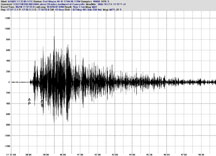

Shake, Rattle, and Roll—Welcome to California
By Denise Devall
Are you prepared to ride out "the Big One"? In California, April is Earthquake Preparedness Month, which offers an opportunity for Scripps Research Institute employees in La Jolla to take inventory of how prepared they are for an event of this kind.
To find out if you have taken the necessary precautions for an earthquake, look around your area—whether it is a lab, office, or other type of space—and ask yourself the following questions:
-
Do you see large or breakable items on high shelves? Move them down to lower cabinets that have secure latches. Even small knickknacks on shelves may be "locked down" using Velcro® dots, double sided tape, or craft putty.
-
Are chemicals stored properly? Think about incompatibility issues and secondary containment.
-
Are there shelf lips in front of chemical storage shelves? If not, fill out a Form 75 work request to get them installed.
-
Are the latches to your chemical storage cabinets working properly? Again, a Form 75 work request can bring someone to fix them.
-
Are aisles and corridors clear of clutter so that you and others can get out of the building quickly and safely in the event of an emergency?
-
Is heavy equipment anchored to desktops or counters by means of earthquake tethers? These are available at many hardware stores.
-
Are gas cylinders in your area securely chained both at the top and bottom one-third of the unit? Make sure they are, and that they are capped when not in use.
-
What about tall freestanding bookshelves or file cabinets? Are they anchored securely to walls? A Form 75 request will bring help.
-
Do you have lots of heavy books overhead? Can they be moved down? If not, you may be able to restrain them using bungee cords.
-
Do you have a clear area under your workstation to "duck, cover, and hold"? Take time to clear out some "safe" areas in order to have a place to go if the shaking starts.
Many people at Scripps Research have never experienced an earthquake. Periodic earthquake drills in your lab or workplace will help everyone know what to do when—not if—the Big One hits.
For more information on earthquake safety, visit the following web pages: The State of California Office of Emergency Services, San Diego County Office of Emergency Services, and Laboratory Earthquake Preparedness (UCSD—EH&S). In addition, the SBC White Pages (Customer Guide section B) provides an easy-to-read guide to first aid and survival that outlines what to do at home before, during, and after an earthquake.
Send comments to: devalld@scripps.edu.

April is Earthquake Preparedness Month. Image courtesy of Indiana University-Purdue University Fort Wayne.
